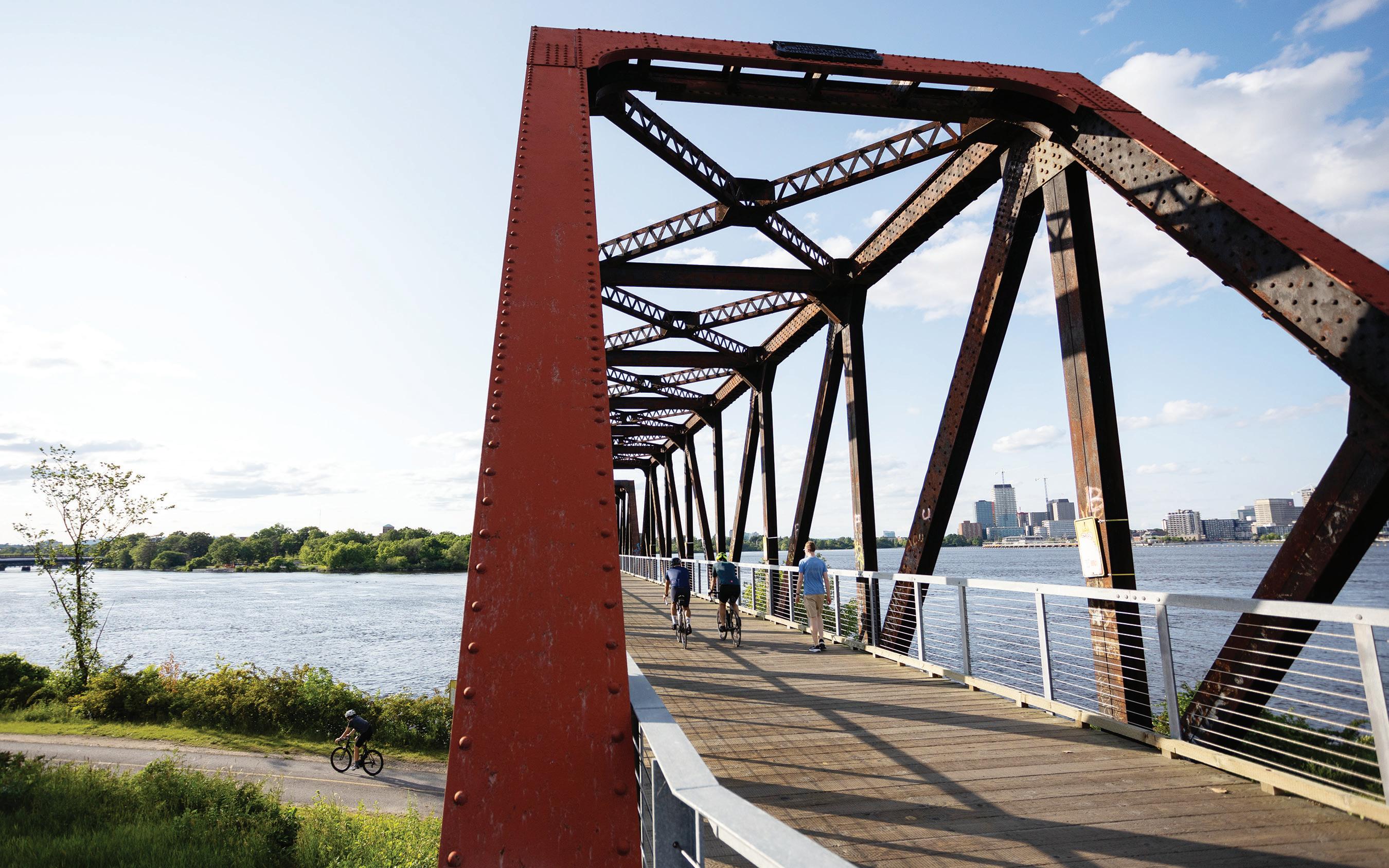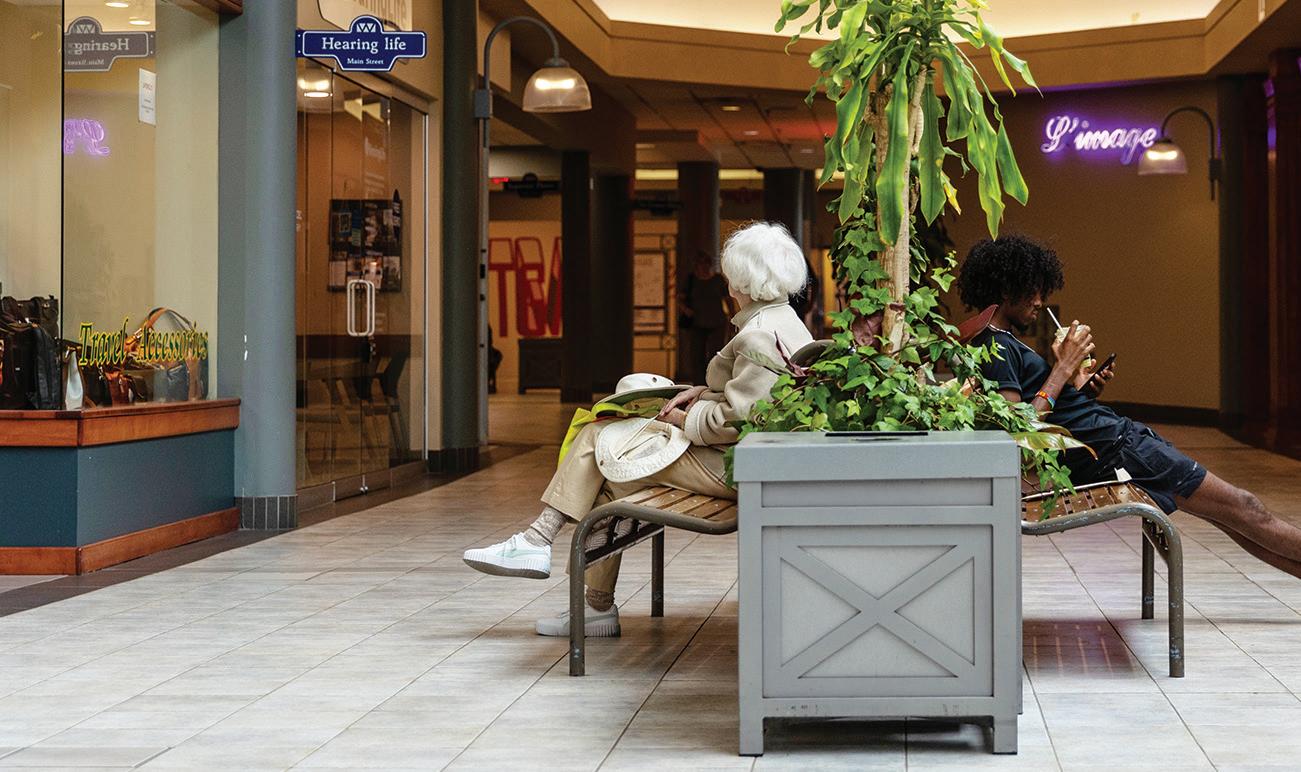KITCHISSIPPI TIMES



























BY CHARLIE SENACK
We know how much you love reading about what’s happening in your neighbourhood, and that is why starting this month, we will be posting exclusive local content to our website that you won’t be reading here in the print format. Why? Community news is undeserved in the Ottawa area. Even mainstream publications are dealing with fewer resources. But because we are community-driven and supported by the fabulous advertisers in our community,
what we bring in gets invested back into our coverage zone.

Expect to read about the latest news from city hall, events happening in urban Ottawa, stories from local businesses, food, and so much more. There are so many stories not being told these days, and we want to do our part to change that.
But we can’t do it without your support. As readers, you are our eyes and ears on the ground. If you think a story
is worth covering, email us at editor@kitchissippi.com. You can also send us provided content, which, if we will is right for our audience, will be posted to our website. So, regularly visit Kitchissippi.com for the latest community news, and be sure to sign up for our free online newsletter, which is delivered to your inbox as it happens.
Enjoy the rest of what summer has to offer, Kitchissippi!










KITCHISSIPPI TIMES
Great River Media Inc PO Box 91585
Ottawa ON K1W 1K0
The Kitchissippi Times is an award-winning newspaper that has serviced Westboro, Wellington West, and surrounding communities for the last 20 years. The word Kitchissippi, meaning “great river” in Algonquin, is the former Indigenous name for the Ottawa River.
STORY IDEA? editor@kitchissippi.com twitter.com/kitchissippi
EDITOR
Charlie Senack charlie@kitchissippi.com twitter.com/charlie_senack
CONTRIBUTORS
David Cummings, Amanda McLeod, Anita Murray, Dave Allston, Keito Newman, David Sali and Patrick Langston.
PROOFREADERS
Susan Rothery
ADVERTISING SALES
Jennifer Tackaberry 613-696-9482 jennifer@kitchissippi.com
CREATIVE DIRECTOR
Tanya Connolly-Holmes creative@greatriver.ca
GRAPHIC DESIGNERS
Celine Paquette celine@greatriver.ca
FINANCE
Cheryl Schunk, 613-696-9490 cheryl@greatriver.ca
All other enquiries 613-696-9494 info@kitchissippi.com
DISTRIBUTION
A minimum of 16,000 copies are distributed from the Ottawa River to Carling Avenue between the Britannia and Preston Street communities. Most residents in this area will receive the Kitchissippi Times directly to their door. If you would like to become a distribution point, please contact us. Copies are available at Dovercourt Recreation Centre, Hintonburg Community Centre, and dozens of other pickup locations in the area.
DISTRIBUTOR Comet 2000
info@kitchissippi.com
The Kitchissippi Times is published by

FOUNDER PUBLISHER Mark Sutcliffe Michael Curran




Top to bottom: The Taste of Wellington is back on Sept. 20.
The West End Studio Tour is showing the community's greatest talent during two weekends in September.
The Parkdale Flower Market is a way to bring some colour into your home this fall. PROVIDED PHOTO.
BY CHARLIE SENACK
It’s that time of year when kids head back to the classroom and parents are settling back into work full time after enjoying some well-deserved time off. While the return to routine is nice, it can feel a bit depressing knowing that summer is over and winter isn’t that far off. Sorry… I had to say it! But have no fear: there are plenty of fun events to enjoy over the next few months before switching your shirts in for snow pants.
What: Enjoy an evening of Dueling Pianos featuring Jeff Rogers and Mellow Dee. Following the show, Happy Hour begins at 9:00 pm, with games, Darts Reimagined, and additional food and beverage service. Tickets are $20.
When: September 4
Where: Manor Lounge, 292 Elgin St escapemanor.com/ottawa
What: Don’t just watch as Ottawa turns into a night in Havana - be there! Join thousands at the Latin Sparks Festival for a night entrenched in Latin Culture. Start the night with Latin dance workshops to get your groove on, then cool down with drinks from the bar and a bite to eat from the authentic Latin Food trucks.
When: Sept. 6
Where: LeBreton Flats latinsparks.ca
What: The One World Grannies with the Aylmer GoGos invite you to join us for a Grandmothers Bridge Crossing & awareness raising event on National Grandparents Day. It is open to the public and we welcome
everyone. Learn about the impacts of the Trump administration’s devastating cuts to USAid’s HIV and AIDS and other aid programs on sub-Saharan communities, the Stephen Lewis Foundation (SLF)’s Grandmothers Campaign, and how to help Bridge the Gap left by fund withdrawal. Folks will be encouraged to write messages of hope and support for the grandmothers in sub-Saharan Africa.
When: Sept. 7 (rain date of Sept. 14), from 10:00 a.m. to 2:00 p.m.
Where: Adawe Crossing Pedestrian Bridge in Strathcona Park, Range Rd
What: Explore a variety of themed markets at The Art Hub and The Warehouse, each offering a unique shopping experience.
When: Sept. 13
Where: Urban Art Collective, 1088 Somerset St W, and The Warehouse, 28 Booth St. urbanartcollective.ca
What: Celebrate the fall harvest with bold flavours, seasonal dishes, and a warm sense of community. This unique culinary event features tasting stations by local chefs and beverage artisans, all in support of Youturn Youth Support Services. Tickets are $125 each.
When: Sept. 17, from 6:00 p.m. to 10:00 p.m.
Where: Ottawa Art Gallery, 10 Daly Ave harvestottawa.ca
What: Your local farmer-florists are bringing an array of beautiful blooms from the Ottawa Valley to the heart of Kitchissippi. Create your own stunning bouquet at the build-your-own bouquet bar or choose from
a selection of ready to go bouquets carefully crafted by our florists.
When: Sept 20 and Oct. 11, from 9:00 a.m. to 1:00 p.m.
Where: Parkdale Public Market, 366 Parkdale Ave ottawaflowermarket.ca
What: More than 50 Hintonburg and Wellington Village restaurants and shops will be offering free food samples, discounts, sales and entertainment in Wellington West neighbourhood. When: Sept 20, from 10:00 a.m. to 6:00 p.m.
Where: All along Wellington St W. Wellingtonwest.ca
What: It's the 30th year of the West End Studio Tour! This year it welcomes five new artists: Matt Ficner (puppeteer & character creator), Joanne Foster-Komendat (watercolour), Cate Green (oil and acrylic), Kate Punnett (pressed floral) and Jennifer Simpson (cold wax & acrylic).
When: Sept 20-21 and Sept. 27-28
Where: Throughout Westboro and Wellington West westendstudiotour.com
What: Dance and sing along as Aqua brings nostalgic ‘90s energy to the stage. Known for infectious hits like Barbie Girl, this DanishNorwegian Europop sensation delivers a high-energy show filled with throwback favourites. Experience the era of bubblegum pop in an unforgettable performance. Tickets starting at $61.
When: Sept. 20, at 8:00 p.m.
Where: National Arts Centre Southam Hall, 1 Elgin St nac-can.ca
What: The Westboro Region Food Bank is hosting a fundraising auction selling pieces from the beloved Whispers Pub. Locals will be able to take home a piece of the local staple, while giving back to their community. You can also eat at the community lunch for only $15.
When: Sept 20, from 10:30 a.m. to 2:30 p.m.
Where: All Saints Westboro Anglican Church, 347 Richmond Rd allsaintswestboro.com
What: The Ottawa International Animation Festival (OIAF) is one of the world’s leading animation events, providing screenings, workshops, and entertainment since 1976. OIAF is an annual five-day event bringing art and industry together in a vibrant hub, attracting artists, producers, students, and animation fans from around the world.
Tickets are $15 each.
When: Sept. 24-28
Where: Various locations including: ByTowne Cinema, Arts Court, Club SAW, Strathcona Park, the National Arts Centre, and the Ottawa Art Gallery animationfestival.ca
What: Come celebrate agriculture in Ottawa’s countryside, with shows, exhibits, entertainment and good oldfashioned fun.
When: Sept. 25-28
Where: Carp Agricultural Fairgrounds, 3790 Carp Rd carpfair.ca
BLACK HISTORY OF OTTAWA STREETS
What: Come learn about Canada's rich Black History through landmarks in Ottawa.
When: Oct. 1, 4, 8, 11, and 18
Where: Ottawa City Hall, 110 Laurier Ave W www.blackhistoryottawa.org
A MIDSUMMER NIGHT’S DREAM
MEETS ALL HALLOW'S EVE
What: There are strange things afoot on the night of the new moon. A haunted
wood, warring spirits, befuddled young lovers, a mischievous goblin, potions and spells, a dream within a dream within a dream…. Be careful what you dream about, it might come true! Be prepared for some spooky fun. Tickets are free.
When: Oct. 2-4
Where: Gladstone Theatre, 910 Gladstone Ave. thegladstone.ca
What: Enjoy this major agricultural fall fair that began 11 years before Canada's Confederation.
When: Oct. 2-5
Where: Metcalfe Fairgrounds, 2821 8th Line Rd metcalfefair.com
What: Halloween is making its way to the streets of Westboro! Enjoy plenty of free trick-or-treat stations throughout the Village with lots of spooktacular experiences.
When: Oct. 25, from 1:00 p.m. to 4:00 p.m. Where: Along Richmond Rd Westborovillage.com
What: Who doesn’t love a little blast from the past? Peruse and purchase antique and rare books of all genres, as well as maps and paper ephemera. Demonstrations and talks on historic bookbinding techniques, the history of books and book collecting throughout the weekend.
When: Oct. 25, 10:00 a.m. to 4:00 p.m., and Oct. 26 from 10:00 a.m. to 3:00 p.m.
Where: St. Paul University, 223 Main St ottawabookfair.ca
What: If America is a show, then John Wilkes Booth was its first star. A well-known stage actor, Booth shot Abraham Lincoln during a performance on April 14, 1865. In that moment, he kidnapped reality and transformed it into theatre. Generations later, Mark Killman – a feared but much-admired director – hires two actors to stage Lincoln's assassination. The actors play comedy duo Laurel and Hardy, while Killman plays Lincoln as a wax figure. Tickets start at $42.
When: Oct. 28- Nov. 9
Where: Great Canadian Theatre Company (GCTC), 1233 Wellington St W gctc.ca
Get back in the swing of things with Fall programs at Dovercourt. Swim lessons, fitness, arts, sports and more are all starting soon!
Check out free fitness and sessional recreation classes (arts, dance, sports & more) for the week of Sep. 8-14.
See the flyer on our website; book in advance on our website.
Our indoor pool is closed for annual maintenance between Aug. 25 to Sep. 12, reopening for lessons, aquafitness and drop-in swims on Sat. Sep. 13.
Enjoy exclusive access to 45+ weekly group fit, spin and aquafit classes, the Fitness Centre, pickleball and even access to drop-in swims with your monthly Fit Pass.
Fall Specialty Fitness and Aquafit classes start in September. Yoga, strength, Pilates, spin, pre and postnatal, TRX, barre, Aqua Zumba, Water Walking and more!
• Free Movie Night: Friday September 12
• Inclusion Dance: Saturday September 13, 7-9pm



BY CHARLIE SENACK
Where a once bustling mall stood, there is now open ground – a blank slate awaiting a new planned community, mixed with large residential towers, retail, and green space. It’s the urban city dream where all basic amenities are within walking distance. But as shovels inch closer to the ground, not everyone is happy with the city's vision.
In November last year, city council approved the Lincoln Fields Secondary Plan, which will help guide the development of the parcel of land that was
once home to the Lincoln Fields Mall.
At 2525 Carling Ave, developer RioCan and RLA Architecture have submitted a concept plan to see upwards of 11 high-rises with mixed-use space built on the 6.5-hectare area. Most would range from nine to 40 storeys, with the tallest towering 45 storeys.
Most in the community are welcoming the addition of more housing and are excited about the new opportunities it will bring. But as Trevor Proulx from the Mud Lake Community Association points out, there will also be a need for more essential services.
“It is just going to be like this curtain
of 30-storey or more buildings. I think the infrastructure is going to be a problem. Right now, the neighbourhood schools are already full,” he said. “Carling Avenue is one of the worst streets in Ottawa, and traffic is only going to get worse. And then Richmond Road is just one lane each way. So the traffic there is going to get really bad.”
Kathy Vandergrift, president of the Queensway Terrace North Community Association, also shares that concern. She feels the city has allowed “maximum development permissions with little consideration of transportation impact.”
“They want to add the equivalent of
Renfrew – a town of 10,000 people – to the Lincoln Fields area. They are basically building a whole new community," she said.
The city is betting on the opening of the Lincoln Fields light rail station in 2027 to hopefully get many people out of cars and onto public transit. With that comes bike lanes and expanded sidewalks. Not included, though, is a direct linkage from the bus and train stations to the soon-tobe-redeveloped mall site.
Vehicle access to the Kichi Zibi Mikan Parkway from Carling will also change. The giant traffic circles are slated to be removed and replaced with
a T-intersection—a type of road junction where one roadway ends perpendicularly at another road, forming a "T" shape, with no road continuing across the intersection.
Vandergrift said they support that, but are worried about the traffic impacts it will create.
“We will have more backup traffic impacts that will make entrance and exits from our neighbourhood during rush hours almost impossible,” she said.
One component the community would like to see is more shopping options. It suffered greatly when Walmart closed and the mall was torn down. The closest location is now three kilometres away at Bayshore.
Because of leasing conditions, the mall owners were forced to build a standalone Metro Grocery store to replace the old one. There was hope it could have been incorporated into the ground-floor retail space of a building; however, the chain was not interested in that a few years ago. Bay Ward Coun. Theresa Kavanagh now believes they’d be willing to move when the towers are constructed.
While buildings in the centre of the site will have retail options, the towers closest to Carling won't. Vandergrift said the Queensway community is unhappy about that, but Kavanagh said it's because developers struggle to lease some of their spaces.
“It definitely would have made the community more attractive. Carling, unlike Richmond, is harder to feel like a real downtown main street because it's four lanes, and often six lanes of traffic,” she said. “The dream is to have coffee shops and things like that right there. We get a taste of it with Rexall Pharmacy. But from a developer's point of view, that's not an effective use of their space.”
Kavanagh gave the example of the Brigil buildings at the corner of Richmond
and Woodroffe. For the last two years, a sign has been up saying a coffee shop is moving in, but there have been no takers. There will be several new stores in the area of a new main street connecting Carling to Richmond. The new connector will have parkland on both sides in an area that is currently a concrete parking lot.
Perhaps some of the bigger concerns are over the proposed new towers to be built on Edgeworth Drive. Up to 24 storeys are planned for the quiet residential street, which the community said was not made to handle an influx of people.
Under the current plans, the 24-storey component of the towers would be built closest to Carling, with tower heights between 18 and 17 storeys, the closer you
get to single-family homes and low-rise buildings.
Also, by Regina Street, Proulx said there are concerns over the Parkway House development. The current nonprofit long-term home for 12 adults with physical challenges is slated to be torn down, with a new seven-storey building planned for its residents. Next to it would be two towers of 16 and 28 storeys.
“The home for people with disabilities is great. People also need places to live. But the city also needs to think about safety and sidewalks, speed bumps and stop signs, and there are schools around there and kids,” said Proulx. " If you put a big building like that in, it should be off a main road like Richmond. I think it will be a little chaotic.”
We will have more backup traffic impacts that will make entrance and exits from our neighbourhood during rush hours almost impossibles. — KATHY VANDERGRIFT







BY CHARLIE SENACK
What if trains once again went over the Chief William Commanda Bridge?
That is a question city council is asking through long-term planning in the updated Transportation Master Plan, which outlines a roadmap for the most significant transitoriented projects over the next 20 years.
But if it ever did happen, replacing the wooden pathway with tracks would be beyond the 2046 horizon, given the expected investment in the STO Gatineau Transitway, a city report outlined. The bridge could then be used as a “potential future interprovincial rail link” between the transit networks in both Ottawa and Gatineau.
A previous 2013 Transportation Master Plan identified using the bridge as part of a light rail network. However, in 2019, former Ottawa Mayor Jim Watson said it would never be used again for trains, saying it would cause too much congestion at Bayview Station.
Former Gatineau Mayor Maxime Pedneaud-Jobin agreed. He said studies had been conducted over a few months, which showed the former Prince of Wales rail bridge could not be used, and said the Portage Bridge was seen as a better contender to connect the two communities.
Since then, the rail bridge has been renamed after Chief William Commanda, an Indigenous leader who connected communities and taught Canadians about the traditions, languages, and importance of the First Peoples of Canada.
A $22 million investment was made in the bridge to make it a multi-use pathway. After its first week in operation in August 2023, almost 30,000 people crossed by foot or bike.
The city is considering using the Chief William Commanda Bridge for a light rail link between Ottawa and Gatineau sometime after 2046.
BY KEITO NEWMAN.

Ottawa is rapidly growing and is expected to reach 1.4 million people by 2046. That will bring an estimated increase of 1.2 million daily trips, 620,000 of which will be by vehicle.
Roads and transit infrastructure must be upgraded to meet the demand. The updated Transportation Master Plan outlines $3.9 billion in capital projects across the city.
New bus lanes on Carling Avenue would benefit Kitchissippi and Bay Wards. When first elected, Coun. Theresa Kavanagh thought progress would have been made by now, but it’s been stalled by the Baseline bus
rapid transit project, which has been given a bigger priority. Under three phases, it would take buses 13.8 kilometres down Baseline Road from Bayshore to Heron.
“There are lots of costs involved, which is why Carling is not going first,” said Kavanagh. “What I thought was imminent has now been pushed off. And I’ve been very frustrated with that. I’ve also been asking for cycle infrastructure over and over again, stating how important it is. And the city is just not making those investments.”
Carling Avenue has also been voted as the worst road in Ottawa this year.
Other transit-oriented projects across
the city include: new transitways in Kanata and Cumberland, new bus lanes on Blair Road and St. Laurent Boulevard, the Airport Parkway widening, and the Greenbank Road realignment in Barrhaven.
The city has also committed to building Stage 3 light rail to Kanata, Stittsville, and Barrhaven, though previous numbers released by OC Transpo paint a difficult financial situation for the project, given lower-than-anticipated ridership. During the recent provincial election, Ontario Premier Doug Ford committed to offloading the LRT system to the province and funding the suburban expansions.






BY AMANDA MCLEOD
It’s no secret that millions of people around the world lack stable, safe and secure housing. Unfortunately, the numbers only keep rising. It’s in part why Amanda Sterczyk and Shawna Thibodeau
networking event in Ottawa. After Thibodeau was — unexpectedly to her — invited on stage to speak about her work, the event organiser, Catherine Landry, issued a challenge to the audience: What do you already have, without buying anything, that you can offer as support?
Sterczyk’s answer was to use her writing skills to help tell the story of Shawna’s Outreach.
Thibodeau is the driving force behind the local grassroots organization. You may have seen her posts on Facebook or caught her out in the community, offering support and care bags to unhoused and homeless people across Ottawa, including regular stops at Dundonald Park and through the Preston and Somerset Street areas.
The foundation of her work is the belief that there is already enough “stuff” in the world. Thibodeau argues that issues of scarcity are less about lack and more about how society shares — or hoards — resources.
“We already have enough to share. We don't need to spend money,” she says.
When people offer to donate, she first asks them to consider what they already have on hand.
“I would rather you give me the toiletries you collected from hotels over the last 10 years,” says Thibodeau. “Or the package of underwear in your drawer that you're not wearing — you opened it, took one out, and didn't like them. Or the Costco-size box of snacks your kids don't like anymore. Or you're going through menopause — how many women go through it and they've got open pads, tampons and liners sitting in their house and are like, what do I do with this now?”
Originally from Nova Scotia, Thibodeau is no stranger to hardship. She and her son came to Ottawa in 2008 to escape an abusive home environment. Upon arrival, she experienced first-hand the challenges of accessing support while starting over with nothing.
fix the roof. So when I got [to Ottawa], I was already used to bartering and volunteering. I'll give you my time, you give me whatever. But we don’t do that here.”
She recounts her time in a shelter prior to moving to Ottawa and how it sparked her future direction.
“At the time, I had nothing, and I went on Freecycle.com. I saw a woman looking for hotel-sized toiletries and purses to give to women in shelters — and I had received a purse in my shelter. So I messaged her and said, ‘Thank you for doing this, it really matters.’ And I said, ‘I have absolutely nothing to give you but my time. But if I can help, let me know.’”
That experience framed how she would build her life in Ottawa. It also inspired her long-standing commitment to volunteerism and advocacy for vulnerable, primarily homeless, populations.
The Shawna’s Outreach Facebook page describes her work as “helping vulnerable populations in Ottawa since 2009. Unpaid, unfunded, unstoppable.”
A scroll through the page shows post after post featuring donated items — from granola bars and water bottles to socks, backpacks, toiletries and gift cards — all quickly assembled into care bags and distributed.
“If I get stuff for outreach, I have a seven-day turnaround to make my bags and get to the street. But I can't store this in my house,” Thibodeau says with a laugh. “My husband and I won't be friends anymore.”
She explains that some people have asked why she doesn’t donate everything to shelters or food banks.
“Well, shelters and food banks have budgets for that nowadays. They get regular donations from a variety of companies. But there’s a whole other side — I don’t post a lot of what I do. A lot of it is behind the scenes: rescuing things, saving things, connecting people.”
co-authored the book When We Each Do a Little, We Can Do a Lot.
Sterczyk, an Ottawa-based author, is best known for her wellness writing and, more recently, her foray into fictional crime stories.
She met Thibodeau at a women’s
With a background in education, Thibodeau began volunteering at her son’s school to meet Ontario Works’ requirements for volunteer work, which could potentially lead to employment. But even then, she struggled to cover basic living costs without a community or support system.
“Where I come from, if your roof needs fixing, you call up a bunch of neighbours, buy a case of beer, and
“I’m involved in things where I’m helping save stuff from landfills — Amazon, Costco, Walmart. There are loads of tractor-trailers a day going to landfills in every city in this country because we’re a disposable society. And I was invited by one of the women who helps sort that stuff to see if we can find anything useful for the people on the street — at least give it one more life cycle before it ends up in the garbage.”

























BY DAVE ALLSTON
Hintonburg was still just a tiny, growing hamlet in 1878 when butcher Joseph Hanrahan arrived, full of dreams and aspirations. He was a 30-year old budding genius, a visionary who had been around meat since birth, who foresaw the benefits of growing the family butchery business outside the city limits.
It was during those early days in Hintonburg where Joseph would develop and trial many inventions which eventually would revolutionize refrigeration and the transport of perishable food. His name and contributions have been long forgotten, but he played a key role in changing early Hintonburg, and his work would literally change the world.
The Hanrahan family first arrived in Bytown in 1847, getting into the butcher business right away. Catherine Hanrahan was a widow in her 50s who opened a ‘victualler’ stall in the market, along with her two sons, who eventually took over the
business. Her grandson, Joseph was born in May 1848, not long after the family’s arrival in the city. Over the next 86 years, he would lead an incredible life off the foundation established by his grandmother.
As his life’s work would show, Joseph had varied interests outside of the family butchery business. As a young man, he started working as a blacksmith for John and William Ahearn, older siblings of Thomas Ahearn – perhaps Ottawa’s most well-known inventor, who helped bring electricity and the streetcar network to Ottawa.
By 1875, Joseph had returned to the butchery business, opening the firm “Hanrahan Brothers” with his brothers Thomas and Timothy in LeBreton Flats at a “beef stall” by the entrance to Pooley’s Bridge. Later they would settle into more permanent locations at the Wellington Ward Market (corner of Sparks and Lyon) and in a shop at 166 Sparks Street.
The operation of a butchery at the time was complicated. Meat had to be sold very fresh, as refrigeration and storage methods were primitive. Thus butchers tended to
keep their own livestock.
sponsored by

Timothy Hanrahan provided a thorough tour to an Ottawa Citizen reporter in April of 1884, who described the modern, impressive facilities, including the ‘hog bin,’ the 40x24 foot cattle-killing room, stables, ice house, and weigh house (now the vacant lot at the southeast corner of Merton and Armstrong). The Hanrahan family resided in a home built on the property. Reports called the Hintonburg operations “beyond a doubt the best in the Dominion.”
The Hanrahans smartly acquired two lots in Hintonburg on the north side of Wellington Street (then still called the Richmond Road), at first through a lease in 1878, but eventually through a purchase in 1882, and opened up a small shop and “pork packing” facility.
Operations in Hintonburg initially focused on the pork side of the business, which advertised “sugar cured bacon and hams, barrel pork, spare ribs, fresh pork, sausages, bologna sausages and everything in connection with the pork business.”
It was noted in December 1882 that Joseph, “with commendable enterprise,” had connected his pork packing business on Richmond Road with his Sparks Street branch via telephone, enabling orders from anywhere in the city.
The Hanrahans were not only butchers and pork packers, but also livestock dealers, travelling far and wide to acquire only the best animals for their firm. Soon they would expand, acquiring nine adjoining lots in Hintonburg to create a huge property several hundred feet wide.

Intriguing the reporter most of all was the new modern refrigerator. Said to be the “best planned refrigerator on the American continent,” he wrote that it was “able to keep meat for four months during the hottest days in summer and … turn it out for sale as tender and more choice than it was on the day it was killed. In the refrigerator there are over 2,000 pieces of ice piled on the top of each other some thirty feet in height.”
Operations were complex, but efficient and humane. Fifteen workers were employed at the Hintonburg plant, which aside from railways and mills, would have easily made it the area’s largest employer at the time.
The Hanrahans became known as “the Butcher Kings.” A visiting butcher from London, England stated the Hanrahans had the “best killed beef which he had ever seen anywhere in his life.”
The growth of the operations in Hintonburg was vast and quick, and while Timothy may have been an expert cattle buyer, it was Joseph who was the brains behind the operation. And he knew that solving the refrigeration and preservation question was the key to success.


Throughout the 1880s, he filed patents not only for inventions such as rock drills and garden sprinklers, but he began getting deeply into refrigerator systems, refrigerator buildings, and refrigeration cars for rail and ship travel. Over a dozen patents with complex schematics were filed for these and many other inventions, in both the U.S. and Canada. (Into his 80s in the 1930s, he was still submitting new plans for cold storage buildings, evaporators, drying kilns, fans, clothes drying facilities, oxygen chambers, and more modern refrigeration systems. It’s hard to imagine there was a more prolific inventor in Ottawa over this 50 year period.) Doubtless, many of his inventions were trialed at his Richmond Road abattoir.
His patent refrigerator was revolutionizing meat preservation across North America in the 1880s. He was called across the States to help manufacture more and more refrigerators, and in the fall of 1886, installed units on ocean steamers (the Sardinian, the Vancouver and the Oregon) to carry meat and fruit overseas,which was a game-changer. “In plain English, they have struck a bonanza,” trumpeted one report.
Joseph was proud of his innovation, as the refrigerators were constructed “on scientific principles,” and “can be made of any shape, design or size, thus placing them within the reach of rich and poor.”
That same fall of 1886, Joseph oversaw the opening of the Automatic Refrigerator Company, located at the corner of Lyon and Wellington, to manufacture his refrigerator units. Within a couple of years, Joseph sold his interests in the Ottawa companies and moved to the U.S. to focus on opening factories for his refrigerator car in centers like Detroit, Chicago and New York City.
His brother Tim Hanrahan took over

the butchery in 1889, and renamed it the Hanrahan Meat Company. Perhaps he felt the business had outgrown the village. Hintonburg was still small but growing quickly. By this time, it was home to two grocers, two general stores, a fruit seller, baker, carriagemaker, grain elevator, flour mill, carpenter, and a blacksmith.
Tim found a new home on 40 acres of land, which is now the area north of Scott Street to the River, comprising Island Park Drive, Remic Avenue and Latchford Road. Then it was empty grassy fields, which made the perfect locale for a new slaughterhouse and stockyards. Further agreements were made for use of adjoining lands going west, giving Hanrahan plenty of space to build a new 110x22 foot main building, a 30x40 foot piggery, a 24x30 foot refrigerator, a 50x20 foot ice house, a 50x50 foot packing house, and a 20x20 foot “sausage room,” among other buildings. In fall 1890, not long after opening,


there were 390 cattle, 440 sheep, and 240 pigs on hand, plus hundreds of other animals being penned on farms to the west. It would have been an impressive operation in an isolated location.
Hanrahan not long after sold the property to fellow butcher Richard N. Bishop in 1891, though they likely had a shared usage agreement for the abattoir.
In 1900, Robert H. Cowley purchased the property and later laid out a residential subdivision with his partner Francis R. Latchford. The old slaughterhouse buildings were abandoned, and years later there were stories of children in the vicinity finding quantities of old horse teeth while digging in the dirt.
Meanwhile in the early 1900s, Joseph Hanrahan was solving the universal problem of shipping perishable fruits. Previously, fruit dealers had to pay expensive express shipping fees for distant fruit, but Joseph’s new refrigerator cars


1. Bennett's City of Ottawa Directory from 1888.
2. Field & Factory Magazine from Sept 1888 - an ad from the Automatic Refrigerator Company showing Hanrahan's refrigerator.
allowed for fruit to be sent on ordinary freight charges and arrive in better condition. He received a contract from the provincial government for his cars. He also built a cold storage plant at the Ontario Agricultural College in Guelph.
Joseph later got into modernizing dry cleaning and drying facilities, said to be the most effective method of drying clothes yet seen. He used businesses such as Mason’s Mill in Hintonburg to test some of his designs. He continued inventing his entire life.
Joseph returned to Ottawa late in his life and passed away here in 1934.



Elmwood is more than just a school, because she’s more than just a student.
To them, we’re a support system, a studio, a playground, a blank canvas. Here, they can explore beyond the curriculum, developing passions and skills that help them achieve whatever they can imagine.
Extensive co-curricular + sports program
International Baccalaureate World School, Pre-K to Grade 12
Robust financial aid program
Healthy meals prepared onsite
Transportation and before +after care available




BY CHARLIE SENACK
It was October last year when Carole Rocheleau got the news no one wanted to hear: she had cancer. It was in the lungs and liver; the prognosis was not good. But she kept her spirits high and fought hard. Her battle came to an end on March 19 of this year.
But in sadness there can also bring a chance to spark hope. That's at least how her son 32-year-old Tyler Booth looked at it. He wanted to find a way to keep his mother’s legacy alive while helping others.
The employee at Fresh Air Experience, a bike tune-up and repair service in Wellington West, was already training for the Ironman Triathlon after first hearing about the race from his colleague Sam Smith. However, he did not really know what he was getting into.
“It sounded like a pretty cool idea. Initially, I thought it was like a Spartan Race or like an obstacle course run thing,” Booth told KT. “Quickly, I really realized that was not the case. But seeing how hard it was and how much of a challenge it was going to be, made me want to do it even more.”
Booth began his training before Rocheleau got sick. After the prognosis, he kept training six days a week while working full time and taking care of his fighting mother.
A team of six friends – the others had all known each other from the Rideau Canoe Club – had decided early on they wanted to raise money for a good cause. After Rocheleau’s passing, one of them suggested raising money for the Canadian Cancer Society.
“The guys right off the bat were supportive,” said Booth.
Booth felt it was the least he could do. After all, it was always in Rocheleau’s heart to give back.
“She treated everyone like family, even strangers. She had endless empathy for people; she was just so caring,” said Booth. “My mom loved her family so much. Even when she was fighting cancer and knew in the back of her mind that it wasn't going to end well, she was always reassuring us, taking care of her family first and making sure that we're okay. I felt extremely blessed to be raised by such a wonderful person.”
On average, 675 Canadians are diagnosed with cancer every day, with 241 people sadly losing their lives from the disease in this country every 24 hours. Lung cancer is the most commonly diagnosed form of the disease in Canada, with about 32,100 citizens being diagnosed with it per year. Around 20,700 Canadians were projected to have died from it last year – accounting for nearly one-quarter of cancer-releated deaths in Canada.
Smith, who has been athletic his entire life, wanted to take part in Ironman to test his resilience. But when the opportunity came to raise money, the 21-year-old was fully onboard. “Everyone is impacted in some way by cancer. I have extended family members who have unfortunately had cancer. Thankfully, none of them have passed away, but it affects us all,” Smith
She was always reassuring us, taking care of her family first and making sure that we're okay. I felt extremely blessed to be raised by such a wonderful person. — TYLER BOOTH
said. “And obviously doing it in support of a friend means so much more to us.”
Ironman is one of the most strenuous triathlons you can compete in. Participants began with a 3.8 kilometre swimming loop in the Ottawa River at Britannia Beach, before embarking on a 180-kilometre bike ride, and then a 42.2 kilometre marathon.
Three sports mean three sets of training. Booth said they tried to participate in at least two a day. The group crossed Ottawa from Mooney’s Bay, to the Dominion Arboretum, and even out to farm fields in the country. They wanted to get a feel for all environments since the course stretched across most of the city.
“It was mentally and physically a lot,” admitted Booth. “Along the way, there were some injuries and obstacles too. But it was all to lead us to victory in the end.”
And that it did. Matt O’Neil was the first of the squad of six to finish the course at 11:09:40. Olan Bradford finished second among his group at 11:32:36. Then came Booth at 11:37:43, followed by Kieran Graham at 11:39:33, Jacob Price at 12:53:25,
and Smith at 13:11:10. Athletes were given 17 hours to complete the entire track.
The group set a goal of raising $10,000, but was able to bring in a little over $26,000 for the Canadian Cancer Society.
Now that the triathlon is over, the group of friends say they are looking to keep in touch and perhaps participate in a similar event in the future.
“It's been awesome being in Ottawa and has definitely made it a very special first time experience participating. But maybe we want to look at getting out there and doing a different one. There's a number of them across Canada and oodles more internationally,” said O’Neil, 21.
Smith agrees – but maybe not so soon.
“It's such a big commitment time-wise, and I still have another year of school left. So maybe not next year, maybe down the line, it's something I'd consider. I think Half Iron Man might be a little bit more feasible though,” he said.
Booth also felt a half Ironman would be a bit more doable. He also has his eyes set on qualifying for the Boston Marathon.
“That's going to be my next goal for hopefully next May,” said Booth.

MP Anita Vandenbeld Member of Parliament for Ottawa

Not every student fits the mold. Some are here to reshape it.

At Saint Paul University, we embrace students who think critically, act compassionately, and seek a meaningful education. Our social science programs are designed to address the most urgent human and global challenges — from mental health and social innovation to ecology, communications, and public affairs. We prepare students to engage with complex issues and drive positive change in the world.


Wildfire smoke and scorching heat did not stop thousands of athletes from participating in Ottawa’s first-ever Ironman, which started at Britannia Beach and ended downtown on Aug. 3
The 3,000 triathletes began with a 3.8-kilometre swim in the Ottawa River, followed by a 180-kilometre bike ride through the city’s parkways, including the
Ottawa City Councillor Bay Ward
110 Laurier Ave. West
Ottawa ON K1P 1J1
Tel: 613-580-2477
bayward@ottawa.ca
3-1-1 for City Services
Kichi Zībī Mīkan. The competitive event then ended with a 42.2-kilometre run through downtown.
Luke Evans from Toronto was the first to cross the finish line, completing his course in eight hours, 40 minutes and 22 seconds.
Gatineau’s Aliisa Heiskanen was the fastest woman, finishing the triathlon with a final time of 9:32:46.
Among the many competitors was
Conseillère municipale d’Ottawa Quartier Baie
110 av. Laurier Ouest
Ottawa ON K1P 1J1
Tél: 613-580-2477
bayward@ottawa.ca
3-1-1 pour services municipaux
Wishing students a happy and safe return to school!


Nous souhaitons aux étudiants un retour scolaire heureux et sécuritaire!
Bay Ward Coun. Theresa Kavanagh, who completed Ironman with a time of 15:52:24
Ironman has committed to staying in Ottawa for at least two more years and will return in 2026.
KT photographer Keito Newman was there to capture it all
























BY CHARLIE SENACK
For generations of west-end Ottawa residents, Westgate Shopping Centre was more than just a strip of retail. It was where you bought your first records, bumped into neighbours on Saturday mornings, or ate lunch at the Clark’s Dairy Bar.
Built in just 11 months and opening with fanfare on May 19, 1955, it was Ottawa’s first shopping mall at the time, boasting wide walkways, modern storefronts, and ample space for over 1,000 cars — a symbol of post-war progress and suburban growth. There were even “smart and stylish” parking attendants wearing suits that resembled Canada’s famous Mounties, with whistles to help direct traffic and park cars.
“Not one or two — but two dozen of the city’s most up-to-date retail establishments have been preparing for weeks, a galaxy of opening day specials that will surprise the most value-conscious customers who visit this modern shopping center,” wrote the Ottawa Citizen the day before the mall's official opening. “No matter where you park, you’ll find every store within easy reach of your car.”
Steinberg's Grocery, which opened its first Ontario supermarket in the mall a few months prior, had air conditioning and piped in music from a speaker system — luxuries in the mid-1950s.
There was even a unique automatic orange juice dispenser where fresh oranges were ground “before your eyes” at the price of 10 cents a glass. A dozen eggs cost only 59 cents, one pound of cheddar cheese about 49 cents, and milk only 22 cents a quart.
“Decorative panels on the walls indicate what lines are sold in that location: steaks, bananas and so on,” the Citizen wrote.
“Steinberg’s surprises you with potted plants, seeds: the bulk of their wide array of cut flowers, ice cream display; the line of folding garden chairs and steel tables.”
At the neighbouring Reitman’s Department store, a Fall Fair in 1955 advertised a children’s duffle coat would sell for under $7 and men’s all-wool suits for just $49.50. An eiderdown blanket cost $2.66, while a stylish coffee table would set you back $11.95. Even an armless sofa bed — a mid-century modern staple — was just $69.50
The land where Westgate sits used to be prime for spring flooding before its development. Real-estate developer Harold Shenkman purchased the first piece of it in 1951 for $21,000, and the other section a year later for $42,000. The project was first supposed to open in 1953 at a price tag of $750,000, but construction soared to around two million dollars. The reason why plans expanded: abandoned rail lines were being replaced by an expressway which today is known as the Queensway.
When doors to the Westgate department store first opened, it was met with a gala and much fanfare. Famed television singers and husband/wife duo Shirley Harmer and George Murray were in attendance, along with tabloid favourites Elaine Grand and Dick McDougal who flew in from Toronto.
There was also a novel motorcade of open counter tables to show off the fashion of 1955, which began at the Reitman’s Rideau Street location and ended at Westgate.
“The west end has never seen a show like it,” reported the Ottawa Journal. “There were famous television personalities [and] gorgeous models in a fashion show on wheels.”
Over the next year, Westgate continued to be an attraction for some of the country’s biggest names. TV star and singer Joan Fairfax was “nearly mobbed” when she introduced one of her records at the mall alongside composer Denny Vaughn. There were also performances from the famous Ink Spots vocal group, and various quartets including the Crew Cuts, the Four Lads, and the Ames Brothers.
Westgate also hosted the Ottawa Rough Riders football team before the opening season in 1955 where head coach Chan Caldwell was presented with a giant horseshoe. The team went on to win the game.
That Christmas, Westgate was the first shopping centre to welcome Santa Claus by helicopter. Lionel “Pete” Durrett, the mall’s administrator, recalled in an interview with the Ottawa Journal: “He landed on the roof, and we had to call in extra guards to hold back the crowds. There were a few anxious moments when I wondered if Santa’s helicopter would go right through the roof, but apart from that, everything went off beautifully.”
Easter saw the arrival of the Easter Bunny at the mall — but the costume was lost on its way from Montreal, and Durrett had to dash down to the train station to find it.
But the mall's heyday would not last forever. Shenkman sold the mall in 1960 and turned his focus across the street to the Talisman Hotel which was being built. Known for its famed Beachcomber Room, it too has been lost to history with apartments now built on the site.
In 1972, Freiman’s was sold to The Bay and the Westgate location closed two years later. Then in 1978, the mall was renovated
extensively and became an enclosed space. It had to keep up with the changing times after the likes of Bayshore and St. Laurent Shopping Centres became competition.
The $750,000 project built a glass enclosure around the building with moveable glass walls. It would remain open in the summer to permit airflow and then closed off during the colder months of winter, but the mall space would neither be air conditioned or heated. It was believed at the time that renovated shopping centres would mean a 30 per cent uptick in sales.
A decade later, between 1988 and 1989, the mall undertook a 15,000 square foot expansion that widened it to have stores on both sides and a food court — resembling what it looks like today.
Traffic never fully recovered, and over the coming decades stores would come and go. A three-screen cinema that had opened in 1988 was gone by 2000. Consumers Distributing, a warehouse-like store which sold items through a catalogue and was seen as an anchor tenant after Freiman’s closed, declared bankruptcy and left in 1996. Your Independent Grocer, which replaced Steinberg’s in the late ‘90s, closed in 2003 when Westboro’s Superstore opened. Shopper’s Drug Mart later moved into that space and will remain as a stand-alone once the mall is torn down.




When Westgate Shopping Centre first opened, some Saturdays would see upwards of 15,000 cars pass through the mall's parking lot — which meant Carling Avenue got a whole lot busier.
That pushed then Mayor Charlotte Whitton to announce the road would need to be widened. But with only so much property available to build, she said the Federal District Commission would need to “release a bit of land to the city” and noted the Ottawa Transport Commission would need to lift street car tracks on Holland Avenue and start bus service instead.
In 1956, the city announced plans for an expansion of Carling — two 30-foot roadways separated by a boulevard. Given an increase in vehicle ownership at the time, it was estimated Carling would need to have space for 2,700 cars an hour by 1975. The estimated $2.9 million project would accommodate a peak load of 3,000 cars every hour instead of the current 1,500.
Plans were delayed by a few months given a struggle to receive land from the Central Experimental Farm. The city was requesting to


build an 85-foot boulevard, but the Agriculture Department would only offer 28 feet. Mayor Whitton said a minimum of 38-feet was required.
Whitton reminded officials that when the Civic Hospital received a $3.2 million expansion, officials were under the assumption it would be constructed on an 85-foot boulevard. She also noted Ottawa Hydro was given money from Ontario Hydro to bury Carling Avenue wires under the pretence that the widening would be “something more than a city street.”
But not all hope was lost. A few days later, the city accepted the government plan of 28-feet, but Whitton accused West Ottawa MP George McIlraith with delaying the widening plans. He fired back, saying that was a “complete falsehood” and made a counter charge saying the mayor “mishandled” the matter.
“I told her [Mayor Whitton] that in my opinion the widening of Carling was long needed and was a work requiring urgent city action,” said McIlraith at the time. “I told her I would do all I could to help her out of her difficulties. I might also add I do not understand how she expects to carry on public business in the way she has mishandled this whole Carling Avenue matter.”
The Board of Control voted unanimously to accept Agriculture’s offer It also included plans for a bus bay to be built opposite the main entrance of the Civic Hospital.



1. An old newspaper clipping advertising the opening of Westgate Shopping Centre in May 1955.
2. Crowds gather for the opening of Freimans Department Store.
3. Shoppers take some time to relax at the Westgate Dairy Bar shortly after it opens.
4. Today, only about a dozen stores remain inside Westgate. PHOTO BY KEITO NEWMAN.
5. Dollars Mart has been a Westgate staple for the last few decades. PHOTO BY KEITO NEWMAN.
6. The empty halls of Westgate. PHOTO BY KEITO NEWMAN.
7. A new grocery store and residential towers will soon be built when the mall is torn down. PHOTO BY KEITO NEWMAN.
BY DAVID CUMMINGS
The neon lights still glow at Rockin’ Johnny’s, where the smell of sizzling bacon and fresh coffee fills the air. The old-school diner with its checkered floors and wall decor of a 1957 Chevrolet Bel Air has been welcoming customers to an era past for over 30 years.
Unlike the mall which has been a wasteland of shuttered storefronts for the last couple of years, the restaurant has been able to keep busy. Even during the lull of a late Tuesday afternoon, new customers and longtime regulars like Kim Gagnon populate the 1950s-style pleather booths.
While some new customers read over the menu for the first time, Gagnon and her son Matthew order colas from a waitress who knows them by name. That’s because, according to Gagnon, they’ve come to this Rockin’ Johnny’s at least once every week for the past 14 years.
But the Gagnons’ weekly visits will have to end by October 31 when Rockin’ Johnny’s Diner, like all other tenants, will need to vacate. The mall is finally being torn down to make way for a scaled down residential development. RioCan, which owns the site, says they plan to build a new grocery store attached to the current Shopper’s Drug Mart which will stay. Phase 2 will

The owners of Rockin Johnny’s inside Westgate said they intend to reopen in the neighbourhood, but are still searching for suitable space.
most likely include the construction of two 36-storey towers to the north of the recentlyconstructed apartment building. However, the timeline for that is not clear at this time.
“We’re heartbroken,” Gagnon said. “This is the closest restaurant in the area, and we know the people, we’ve known them for years, so it's hard to say goodbye to the people, let alone the restaurant. We wish they would open someplace closer.”
The two are certainly familiar faces to
Anthony Joseph, who bought the location in 2005. He is starting to worry as the popular diner looks to find a new home.
“I know most of the customers,” Joseph said. “And the other thing, I'm losing my job too until we find another location.”
The same goes for the restaurant’s employees, a few of whom have worked at Rockin’ Johnny’s for well over a decade, according to Joseph. That’s partly why franchise owner Enzo Mastromattei said
that finding a new place nearby is exactly the plan.
“We're trying to find somewhere to reopen in the neighbourhood,” Mastromattei said.
But it hasn’t been easy, and answers have not been concrete. Mastromattei said that although there have been a few possible leads so far, they haven’t landed on a location and are still waiting for responses from landlords.
“If I had an answer now, I would tell you, but we don't know 100 per cent,” Mastromattei said. “But we're looking and getting close to it.”
It’s an unusual situation for such a popular diner to find themselves in. Since Mastromattei opened the first location here at Westgate in 1991, it’s become a staple in the community. In fact, Mastromattei said the diner had leased the Westgate location until 2029.
A Rockin’ Johnny’s location in Kanata might provide a bit of consolation for any customers dedicated enough to drive down the Queensway for a similar experience, but it’s little solace for the regulars here at Westgate who keep coming back, not for the brand but for the people.
“I know that there's other Rockin’ Johnny’s restaurants, but I mean it's not the same. It's not this one,” Gagnon said.



























BY CHARLIE SENACK
The Kichi Zībī Mīkan Parkway. The Trillium Pathway along the light rail system. Or the Trans Canada Trail near Britannia Beach. These are just some of the many places where Ottawa cyclists can ride for pleasure or to connect with other parts of the city.
But did you know there could also be hidden routes which take you where you need to go faster? That’s part of the reason why Bike Ottawa has launched a new cycling guide app, which provides safe and comfortable options.
“I've been biking a long time. and you know what? My perception of getting around the city has totally changed since I started using the app,” said Dave Robertson, a volunteer with Bike Ottawa and a resident of Hintonburg. “I had my route that I would regularly take to get to work. It might not have been the
most direct, but I always want it to be comfortable and enjoyable. I punched in my route on the map and realized there was a whole route I never knew existed – and it was even faster than what I had been taking.”
Robertson said he has heard a lot of these stories from the 4,000 members who have signed up for the app since it was launched a little over a month ago.
The idea for an app originated in 2016. Bike Ottawa had a series of programs online, but they could only be accessed through its website. Then a group from Waterloo Ontario approached the team about turning it into an app-based program people could actually use while on their bikes. About 150 volunteers tested it before the eventual rollout.
“Sometimes a bike pathway or a bike lane might drop you onto a busy street, often unexpectedly. This app fills in those gaps,” Robertson explained. “It gives you a
route that you are more comfortable with and it's colour-coded. Green is good, with pathways or very few residential streets.
When [it] gets to blue, it might be a street which has a higher speed limit. If it goes up to red, then it's a pedestrian place.”
One of the common complaints among cyclists in Ottawa is that trying to bike on busy roads is dangerous. Between 2019 and 2023, there were 62 collisions involving cyclists that resulted in either major injury or fatality. Last year, Ottawa Police reported 123 collisions involving people on bikes.
It can sometimes feel like there are more people on bikes than ever before. Robertson said the COVID-19 pandemic is what inspired people to explore other modes of transportation. A national poll of drivers was conducted by the Traffic
Injury Research Foundation in 2020, which found a 152 per cent increase in cyclists across Ottawa compared to prepandemic levels.
Ottawa is home to a large set of recreation pathways, including many run by the National Capital Commission. The Capital Pathway Network offers over 220 kilometres of paved multi-use trails which also stretch through the Greenbelt and Gatineau Park. The City of Ottawa provides approximately 325 kilometres of city-owned multi-use pathways, 25 kilometres of physically separated cycling facilities, and 340 kilometres of on-road bike lanes.
Robertson has noticed those pathways are getting busier and said he's seeing many more parents teaching their young kids how to ride a bike. His advice for the city is to do a better job of connecting the existing networks.
“We have the Transportation Master Plan. An easy thing that you can do is really speed that up by building what we call using quick build infrastructure. A perfect example is Laurier Avenue, which was a quick build project constructed in 2010,” Robertson said. “There [are] little pin curbs there that separate you from traffic, but it's not a permanent facility. It's cheap, it's fast, and it's relatively easy.”
The app is free to download for all Apple and Android users, and will now be available in other Canadian cities.




Kate Punnett (Sept 20-21)
2297 Lawn Ave
Margaret Chwialkowska (Sept 20-21 & Sept 27-28 )
195 Woodroffe Ave
Janie Jaehyun Park (Sept 20-21 & Sept 27-28)
486 Golden Ave
Pamela Stewart (Sept 20-21 & Sept 27-28)
276 Atlantis Ave
Venz Vesselinov
(Sept 20-21 & Sept 27-28) 320 Whitby Ave
Jennifer Raby
Joanne Foster-Komendat (Sept 20-21)
498 Highcroft Ave
Tracy Armstrong (Sept 20-21)
485 Kensington Ave
Manju Sah Jennifer Simpson (Sept 20-21)
483 Brennan Ave
Alexander Zoubek (Sept 20-21 & Sept 27-28 ) 193 Daniel Ave
Wendy Feldberg (Sept 20-21 & Sept 27-28) 108 Smirle Ave
Joanne Pasieka (Sept 20-21)
45 Huron Ave N
Lynette Chubb (Sept 20-21 & Sept 27-28)
91 Huron Ave N
Deidre Hierlihy
Siobhan Arnott (Sept 20-21 & Sept 27-28) 15 Helena St
Miriam Silburt (Sept 20-21) 102 Kenilworth St
Cate Green (Sept 20-21)
156 Sherwood Dr
Matt Ficner (Sept 20-21)
185 Crerar Ave


BY DAVID CUMMINGS
Recent years have not been easy on Chinatown, which has seen its many businesses through a pandemic shutdown, rising economic pressures and recently, Ottawa’s own complicated opioid crisis has manifested on its doorsteps.
While not a new issue, the social service crisis is showing itself more clearly on the streets. Residents are finding discarded needles on the ground, more garbage is piling up in parks, and there have been increased instances of harassment.
“I don't want to downplay the fact that the impact of people who are struggling with opioid addiction is having an impact on the smaller businesses,” said Dalhousie Community Association president Catherine Boucher. “I think they do because they have nowhere to be now that we've closed the safe consumption site.”
Since the Somerset West Community Health Centre was forced to close its safe consumption site in the spring, reaction in the community is that the problem is only getting worse.
When announcing new legislation about the pending closure last summer, Ontario Health Minister Sylvia Jones said crime in the area was 250 per cent higher than elsewhere in the city. But now we are learning that isn’t fully true.
CTV Ottawa filed a freedom of information request which found crime was only 14 per cent higher in the Somerset area. Police statistics found that the rate was 5,078.83 per 100,000 residents, compared with 4,430 per 100,000 residents citywide. The province hasn’t confirmed where their initial numbers came from.
During this year's AMO conference, Somerset Coun. Ariel Troster questioned
Jones on the data and what the government plans to do to help the area's social challenges. The health minister responded by referring to the death of a woman who was killed by a stray bullet outside a Toronto safe consumption site in 2023.
“With the greatest of respect, I never, ever want to have a mother who is killed because she happens to be in the wrong place at the wrong time in front of a consumption site in the province of Ontario,” responded Jones.
Last year, Northwood Recovery opened a safe supply clinic in Wellington West, but moved a few blocks down to Chinatown after public outcry. Somerset residents made it clear they weren’t welcomed there either, with the clinic later announcing it would close. Residents thought that would be the end, but then New Dawn, a clinic with the same mission, opened there instead.
Multiple requests from this paper to the clinic have gone unanswered.
Tingting Wang owns and operates TTQ Travel Agency. As a travel agent, Wang said she helps locals in Chinatown overcome hurdles like language barriers on their way to vacations abroad.
She said the clinic in the neighbourhood is her greatest concern as a business owner and is often a challenge for her senior clients who like to visit her office in person.
“It's not safe,” Wang said. “I don’t feel safe.”
Despite how she feels working on Somerset Street, Wang said she loves her work and enjoys her clients' vacations vicariously by helping them get there.
“I didn't go there, but I feel like I was there with them,” Wang said. “So, it's happy work.”



Chinatown businesses say crime and illegal activities have gone up since the community's safe injection site closed in March.
PHOTOS BY KEITO NEWMAN
The opioid crisis is not the only challenge Wang has dealt with since she opened her business in 2015, as she encountered the unique challenge of operating a travel agency through a global pandemic shutdown.
“The Chinatown Business community is very resilient,” said Yukang Li, the executive director of Chinatown’s Business Improvement Association. “It is resilience and hard work that the businesses in Chinatown survived the pandemic. And after the pandemic, I think they only worked harder to remain open, to continue to provide service to the community.”
“For that I really want to show my respect to our business members.”
On top of seeing the neighbourhood’s small businesses and mom and pop restaurants through imposing social and economic challenges, Chinatown’s BIA has the added responsibility of keeping their cultural identity alive.
“We maintain our cultural identity by what I would call the hardware and software projects,” Li said.
That hardware is street beautification, which is easy to find around Chinatown. Murals on the walls of buildings, banners
on every streetlamp, zodiac signs in the sidewalk, statues, sculptures and even the bright red garbage cans on Somerset Street have cultural imprints. Not to mention the Chinatown Royal Gateway, the iconic Chinese arch near Somerset and Bronson Avenue and the subject of this article’s feature photo. By software, Li means culturally significant community events like the annual Night Market.
While Chinatown still has its fair share of obstacles to overcome, it’s dealing with issues faced citywide. From a bird's eye view, things could certainly be worse in Chinatown.
“Businesses are struggling post-COVID everywhere, but there's not a lot of papered windows on Somerset Street,” Boucher said. “I think there's parts of Bank Street that have more boarded up windows than Somerset."
But for Li, the added responsibility of keeping the community’s cultural identity alive only adds to the importance of making sure Chinatown continues to endure its many challenges.
“We're not just a commercial district,” Li said. “We are the concrete presence of Chinese culture in Ottawa, and I believe we add to the multicultural tapestry of Ottawa as a nation's capital.”



When markets fluctuate, it’s natural to feel uneasy about your investments - should you make changes or hold steady? At the Caldwell Wealth Management Group of RBC Dominion Securities, we offer professional investment management and comprehensive financial planning that can provide confidence and clarity during turbulent times.
Want a second opinion? We offer a no-obligation consultation on your current portfolio.


Tom Caldwell, MBA, CIM, CFP Senior Portfolio Manager 613-721-8656 tom.caldwell@rbc.com
Samantha Caldwell, MBA, CIM Investment Advisor 613-783-9594 samantha.caldwell@rbc.com
Caldwell Wealth Management Group of RBC Dominion Securities 303 Moodie Dr., 4th Floor, Ottawa, ON ca.rbcwealthmanagement.com/web/tom.caldwell/
and
Used under
of




Featuring breathtaking vistas, indoor and outdoor activities, and a year-long calendar of events, The County is sure to surprise and delight vacationers looking for something different
Discover the charm of Prince Edward County (PEC) this fall – a picturesque Ontario island just a short drive from Ottawa, Toronto, Kingston, and Montreal. With scenic beaches, vibrant small towns, and plenty of familyfriendly activities, PEC is the perfect place to make lasting memories together.
The County, as it’s also called, is perfect for stays of a weekend or a week, with a home-away-from-home atmosphere built for shared experiences and a plethora of year-round indoor and outdoor activities to choose from.
Why make PEC your next holiday destination?
Bordered by Lake Ontario, the St. Lawrence River, and the Bay of Quinte, PEC’s 800 km of shoreline features three expansive beaches, including the world-famous Sandbanks Beach. It also has three acclaimed national parks, as well as three popular towns – Picton, Bloomfield, and Wellington.
PEC also has more than 900 accommodation options to choose from – including boutique and luxury hotels, B&Bs, inns, cottages and home rentals at a range of price points to suit all budgets.The island also has more than 25 restaurants. Additionally, PEC has more than 40 wineries, cideries, breweries, cocktail bars and distilleries. That’s along with many cafes, coffee shops, boutiques, rustic barn studios, antique shops, art galleries, bookstores and shops selling locally-produced artisanal goods.
Evolving into a four-season playground
PEC has recently seen more people visiting in the offseason, says Sonia Houle, owner of Clarke Road Retreat, an eight-bedroom home rental near downtown Picton. Spring and fall has fewer crowds, making it easier to snag restaurant reservations or sip cider on a crisp afternoon. Fall is also the perfect season for wine and cheese tasting with friends or hiking amidst a colourful backdrop.
“During this shoulder season, there tends to be higher accommodation availability with lower night-minimums,” adds Houle, also a Stay PEC tourism marketing organization board member.

Restaurants, shops, museums and art galleries are now open year-round, even in the winter. There are also a number of parks, conservation areas and trails such as the Millennium Trail – a 46-km abandoned railway line that winds through various towns – that offer recreational activities all through the year. Beach walks are also popular in all seasons.
Another major four-season tourist draw is the recently opened Wander the Spa, Ontario’s first-ever lakefront Nordic spa featuring a 10,000 square foot hydrotherapy circuit with saunas, steam rooms, pools, and cold plunges, as well as a restaurant featuring seasonally-inspired menus.
An abundance of activities to choose from PEC is home to some of the best walleye fishing in the world and is popular with kayaking and golfing enthusiasts as well.
Families with kids can enjoy seasonal activities like apple-picking or visiting an alpaca farm. There are also several well-maintained playgrounds, skating rinks and picnic areas, and many of the wineries, cideries, breweries and distilleries also provide family-friendly experiences.
PEC’s year-round calendar of local events, festivals and concerts includes the Prince Edward County Jazz

Festival, Countylicious, Maple in the County, and Firelight Lantern Festival. Guided winery tours with wine tasting and food pairing are also available year-round.
‘PEC is really starting to bubble up’
PEC offers a peaceful haven for those who just want to get away from it all, enjoy quality time together and soak in the relaxing, unhurried pace of life amidst the tranquility of nature. Houle says that while most small towns tend to be limited in terms of one or two notable attractions, PEC has multiple, offering many of the conveniences and hospitality of a big city while maintaining its famous small-town charm.
“PEC is really starting to bubble up,” says Houle, a PEC resident for the past nine years. “Given its welcoming atmosphere, over the past decade many talented creatives from all walks of life have moved here permanently, adding to the cultural richness and arts scene. More restaurants, wineries, and hotels have opened.
“Here you can find all the ingredients a traveller looks for, whether traveling for leisure or business, as an individual, in a group, or as a family. It truly is a hidden gem with something for everyone – and those who have experienced PEC often return.”
JOIN US TO RAISE FUNDS FOR WESTBORO REGION FOOD BANK

IKEBANA JAPANESE FLORAL ART
Enjoy a floral display and make your own flower arrangement to take home!

Westboro Legion (389 Richmond Road)
Suggested goodwill donation $20



Saturday, September 27, 10 am to 2 pm
Westboro Community Association
You’re invited!

Wednesday, Sept. 24, 2025 Time: 7-9 pm Location:
The AGM is open to everyone. Learn more about what we do:
• Chair & Committee Reports
AGM Keynote Speaker
• Community “quality of living” preservation
• Heritage & environment
• Positively influencing intensification
• Community, business & social outreach
Become a member and stay informed!
Membership is $10 cash, cheque at the door, or e-transfer at hellowestboro@yahoo.ca Please
Ottawa’s Leading Community Development Advocate Mr. Toon Dreessen

Join the WCA, Board or one of our committees!


Ottawa’s housing system is under unprecedented pressure. Almost 3000 people are currently without a home in Ottawa, a 78% increase since 2018. This figure is at risk of increasing if investments in supportive and affordable housing fall short. The city’s Housing Needs Assessment highlights the gap: the centralized waitlist for affordable housing rose from 12,447 applicants in 2023 to 15,140 in 2024, yet only 1,155 applicants were housed—just eight per cent.
The challenge goes beyond numbers. Many waiting for housing face complex social and health needs. A fragmented system makes it difficult to transition from shelters or hospitals to permanent homes, leaving too many trapped in cycles of homelessness.
With winter approaching, immediate investments are needed—not only to expand shelter capacity but to build housing-first programs that break the cycle for good.
Supportive housing—permanent homes paired with mental health care, counselling, and life-skills support—consistently delivers strong results. It reduces shelter use, hospital visits, and justice system involvement while improving stability and recovery.
It’s also cost-effective: caring for someone in a psychiatric hospital costs $572 a day, compared to $72 a day to provide housing with community-based support.
A recent audit by Ottawa’s Auditor General echoed these findings and called for stronger performance measures, standardized care models, and better coordination among providers.
Supportive housing provider Ottawa Salus has embraced these recommendations. “It’s going to take all of us lifting together to make the impact that is needed,” says Mark MacAulay, President & CEO of Salus, which has provided supportive housing for nearly 50 years. “When we work together, we can meet people where they are— offering stability, security, and hope for a brighter future.”

Salus is collaborating with partners including Matthew Perry House, The Royal Hospital, Ottawa Community Housing, and Rideauwood on new and existing projects. MacAulay emphasizes the strength of this approach: “We are fortunate to have a network of organizations with deep expertise. When we learn from each other, everyone benefits.”
Salus aims to double its capacity by 2030. The upcoming Capilano building, set to open in early 2026, and Matthew Perry House are significant steps toward that goal—both built through extensive partnerships and consultation.


The annual Soirée Salus, presented by TD and hosted at the French Embassy, reflects this spirit of collaboration—bringing together donors, business leaders, and partners to celebrate progress and raise funds for future projects.
“Soirée Salus is about bringing people together,” says Fiona Murray, event Chair since 2017. “It’s more than a fundraiser—it’s a chance to connect, share ideas, and invest in solutions that change lives.”
Board member and 2019 OBJ FortyUnder40 winner Candace Sutcliffe adds:
“Business and community leaders have a critical role to play—through funding, partnerships, and sharing expertise—to help scale supportive housing and improve outcomes across the city. Partners like Eli Tannis and McDonald Brothers’ Construction exemplify this kind of leadership, and we’re incredibly grateful for their commitment to building a stronger, healthier community. We will be honoring them with two new awards at this year’s soirée: the Salus Changemaker Award and the Salus Community Champion Award.”
With new projects in motion, strong partnerships, and growing community support, Ottawa Salus has the tools to help turn the tide on homelessness— if we act together. The path forward is clear: collaborative action, innovative housing, and community engagement.






since in March
By Anita Murray
Have you noticed? The built-forrental apartment tower craze has officially taken over Westboro and Hintonburg.
It’s been gaining momentum for some time, but the confluence of several projects finishing at the same time has really put an emphasis on the plethora of rental options in the popular neighbourhoods.
In the past couple of years alone, at least six rental buildings have opened for leasing, offering almost 1,700 apartment units on a combined 157 floors. And that’s not counting several other buildings that were built and leased out in the handful of years before that.
“I think the main driver is the lifestyle these communities afford, and the amenities present in them,” says John Thomas of Azure Urban Developments, which has two buildings on the go in Westboro.
“Urban living is a connection to the heart of Ottawa and (these) are 10-minute neighbourhoods. You can walk to great restaurants, groceries, the LCBO, coffee shops, the (Ottawa River) parkway, the beach and, of course, the LRT.”
Along with what the neighbourhoods have to offer and the development of the LTR (Light Rail Transit), Michael Ivanich, director of property management at Richcraft, which recently opened Parkdale Collective across from Tunney’s Pasture, points to the market itself.
“The big reason in the background is we had a shortfall just prior to COVID of 33,000 family units and we never caught up. These
buildings are being built because there is a pent-up demand.”
While he believes the extreme demand has levelled off recently, there’s still more to come.
Colonnade Bridgeport, for instance, broke ground this summer on RYSE, a 22-storey building on Scott Street that backs onto a previous Colonnade BridgePort project called Westboro Connection. It’s expected to be ready in 2027.
In the meantime, here’s a sampling of new-build rental apartment buildings available for leasing now:
Address: 2070 Scott St.
Developer: Azure Urban Developments
Storeys: 26
Units: 254, from studios to three bedrooms
Address: 400 Kirkwood Ave.
Developer: Main + Main
Storeys: 6
Units: 252; studio to two bedrooms, including some townhomes
Address: 159 Parkdale Ave.
Developer: Richcraft
Storeys: 31
Units: 279 units; one and two bedrooms
Address: 377 Winona Ave.
Developer: Azure Urban Developments
Storeys: 6
Units: 60; studio to two bedrooms
Address: 99 Parkdale Ave.
Developer: Brigil
Storeys: 2 towers of 33 and 29
storeys
Units: 520; one to three bedrooms
Address: 300 McRae Ave.
Developer: GWL Life Realty Advisors
Storeys: 26
Units: 334; studio to three-bedroom flats and townhomes with two or three bedrooms


AnitaMurrayistheco-founderof AllThingsHome.ca.Theaward-winning journalisthascoveredtheOttawa housingindustrysince2011.























Every Obasan mattress and bedding accessory is fully customized to your unique needs and handcrafted in Ottawa using 100% organic materials. Complete your bedroom with products designed for lasting comfort, deep rest, and total peace of mind.




By David Sali
There is perhaps nowhere else in Ottawa that is seeing such rapid growth and development as Carling Avenue. Once a street lined with office buildings and shops, it’s turning into a residential hub. And the sights of tall cranes and construction machinery won’t be going away anytime soon.
The city’s 2013 Transportation Master Plan identified the stretch of Carling between the former Lincoln Fields Shopping Centre site and the Dow’s Lake LRT station as a “future rail-based transit corridor.”
The updated transportation master plan released earlier this year now recommends Carling become a “median transitway” serviced by buses.
RioCan Real Estate Investment Trust plans to build six mixed-use highrises ranging from 18 to 40
storeys on a five-and-a-half-acre site at the southeast corner of Carling Avenue and Clyde Avenue North next to a former Canadian Tire store that has been converted into an Altea fitness facility.
Council gave that project, which could include more than 1,700 residential apartments, the green light last year.
At 1655 Carling, Quebec-based Clobracon Construction are building two towers of 16 and 18 storeys that would contain more than 400 rental units.
Meanwhile, Claridge Homes has filed plans to build six highrises containing up to 2,000 housing units just south of RioCan’s property at 891 Clyde Ave. between Carling Avenue and the Queensway. Farther west at 1707 Carling, the same developer is building a 22-storey apartment highrise aimed at retirees.
REVISED PLAN TO BUILD RECORD-BREAKING 50-STOREY TOWER ON CARLING AVENUE
Nearly four years after filing a plan to build a record-shattering 60-storey tower in Little Italy, Claridge Homes has scaled down the design to a 50-storey highrise that would still be Ottawa’s tallest building if the proposal goes through.
The mixed-use complex at 829 Carling Ave. would top out at 166.2 metres, or 545 feet. That’s 23 metres, or about 75 feet, taller than the current record-holder, Claridge’s 143-metretall (469-foot) Icon condo tower at nearby 805 Carling Ave.
The updated proposal calls for 503 residential units, up from 459 units in the original plan. There would also be 3,200 square feet of ground-floor commercial space, a slight increase from the 2,800 square feet Claridge proposed in 2021.
In a move to address complaints that the first plan included too much parking, the developer has slashed the proposed number of vehicle parking spots to 196, down from 385 in the original proposal, while boosting the number of bicycle parking spaces to 267 from 230.
Vehicle parking spaces would be located in a six-storey underground garage accessible from Sidney Street.
According to a site plan recently filed with the city, the building designed by Toronto’sHariri Pontarini Architects would include 264 one-bedroom apartments, 168 two-bedroom units, 48 studio apartments and 23 threebedroom suites.
While current zoning rules limit buildings in the neighbourhood to nine storeys, the city’s secondary plan allows developers to go higher on Carling Avenue near the Dow’s Lake LRT station in an effort to encourage intensification.
Buildings taller than 55 storeys require an Official Plan amendment – a provision that no longer applies to Claridge’s revised proposal, which would still require zoning bylaw amendments.
Noting that the property is within 400 metres of the Dow’s Lake lightrail station, Claridge said the plan represents “a significant redevelopment opportunity of an underutilized
property in proximity to existing transit,” adding the project “will promote the use of transit and increase housing options along this transit corridor, promoting active transportation within the city’s urban area.”
The Ottawa company that’s turning a Slater Street office tower into apartments is targeting a building on a busy corridor just south of downtown for its next conversion project.
KTS Properties has filed an application to turn an eight-storey, 55,000-square-foot office building at the corner of Bronson and Carling avenues into a 70-unit rental complex with ground-floor retail space.
Constructed in 1976, the building at 265 Carling Ave. is currently occupied by a number of commercial tenants but is about 60 per cent vacant.
KTS Properties partner Tanya Chowieri said the structure’s rectangular shape lends itself well to residential apartments and its prime location just west of the Glebe near Carleton University, Dow’s Lake and the future Civic campus of the Ottawa Hospital makes it a natural candidate for a conversion.
“The building has great bones, similar to 130 Slater,” she said. “It has a good layout, good structure.”
Chowieri, who’s hoping the project gets the go-ahead from the city by early next year, said it will likely be completed in two stages. Floors two

to five will be converted to apartments first. Any remaining businesses on those floors will be relocated to the top three levels, where several tenants still have as many as six years remaining on their leases.
The second phase – converting floors six through eight into apartments as well as adding two new commercial units on the ground floor –will be launched once those rent deals expire.
Chowieri said KTS is in talks with tenants about relocating them to other buildings in a bid to get the project finished faster. She’s hoping the first converted apartments will be ready for occupancy within 12 months of the project’s launch.
A prominent Ottawa commercial property management firm is looking at launching its first major development project – an apartment tower on a busy stretch of Carling Avenue that’s seeing a surge in multiresidential construction.
Inside Edge Properties has filed a plan to build a 28-storey highrise with 370 rental units at 1657 Carling Ave. and 386 Tillbury Ave. The oneacre parcel of land between Clyde and Churchill avenues is currently home to two buildings – a two-storey commercial complex that fronts on Carling Avenue and a house on Tillbury Avenue to the north.
The property management firm bought the 24,770-square-foot

commercial property – which features retailers such as a sushi restaurant, pizzeria and tanning salon on the ground floor and office space above –six years ago.
In June 2023, Carlingwood Shopping Centre was sold to a pair of real estate firms that plan to launch a wave of new residential development at the 30-acre site that is now home to the city’s fifthlargest mall.
Vancouver-based Anthem Properties Group and Toronto’s Streamliner Properties Inc. partnered to acquire the 632,700-square-foot retail complex on Carling Avenue, which is anchored by the country’s largest Canadian Tire store. Terms of the transaction were not disclosed.
Opened in 1956, Carlingwood now has more than 90 stores and services, including marquee tenants such as
Loblaws, Rexall and Dollarama. The mall, which is also home to a fitness centre and three banks, attracts more than 280,000 visitors a month.
In a statement, Carlingwood’s new owners said the mall’s proximity to a major arterial road and the soonto-be-completed New Orchard LRT station makes it a “prime location for much-needed incremental residential density,” adding “quality housing is in high demand” in the neighbourhood around the mall.
The developers said they plan to take a “phased approach” to building out the property, which many local real estate observers believe is an ideal location for highrise condominiums on the parking lots surrounding the shopping centre.
This article was repurposed from information on the Ottawa Business Journal website, which is also owned by Great River Media. Visit obj.ca for the latest local business, development and real estate news.

Oneof the first questions homeowners face when choosing hardwood flooring is whether to go with a solid or engineered hardwood floor. Both look and feel the same on the surface, but their construction and performance tell a different story.
Solid hardwood flooring is manufactured a single piece of 1” lumber and is moulded into a ¾”
Solid plank with tongue and grooves. Engineered hardwood will be a sliced veneer of real wood adhered to a stable layered core of wood or plywood. The appearance is identical but engineered flooring has clear advantages – especially in wide planks which are becoming ever more popular.
Wide plank flooring brings a luxurious open look to a space. But the wider a plank of lumber the more that wood will naturally want to expand and contract with humidity. Using solid wood in our climate can often lead to a gapping in the dry seasons and swelling in the summer. Engineered planks built on either a plywood or quartersawn core will provide the planks the stability to stay true without movement as humidity changes. This allows you to install planks from 5” – 12” wide without concern.
Now not all engineered is created equal. It’s important for homeowners to understand what to look for in an engineered floor. Your top layer is your “wear layer”. The ideal size for this is 4mm. At 4mm you’re thick enough that you should have multiple lives for your floor. Opportunities to sand and refinish as they wear throughout the years.
Lengths matter too! Proportions are key when selecting your flooring. Wide Planks need longer lengths to look balanced. While shorter boards in a

narrow planked floor are common, the wider you go the ratio has to follow. Short planks will give a patchwork feel. If you’re in that 5”+ width, the majority of your planks should fall north of 6 feet.
Engineered flooring is built for multiple settings. It can be installed over plywood subfloors but also glued down or floated over concrete in Condo’s or basements. It’s also stable enough to withstand the seasonal climate swings in three season cottages.
If you’re looking for a narrow plank hardwood look, solid hardwood should be fine for the standard application. However, if your design plan includes a wider plank, a high quality engineered wood will outperform solid hardwood every time.

Rob Black President Logs End Flooring











Logs End is Canadian owned and operated manufacture of exquisite custom engineered wide plank hardwood flooring. Tailored to perfection, our bespoke finishes elevate any space. Renowned among designers and architects we’re pleased to offer premium white oak, hickory and reclaimed wood selections to help you create timeless, luxurious interiors.
Visit our stunning showroom at 66 Iber Rd. Stittsville to experience the artistry of premium flooring. Discover more at logsend.com
• Custom Wide Plank Engineered Flooring
• Staircases
• Luxury Vinyl Plank

Showroom: 66 Iber Rd. Stittsville, ON. |
www.logsend.com
• RANDALL’S KNOWLEDGEABLE SPECIALISTS can guide you on style, fabric and the manual or automated lift system to suit your needs
• Discover UNCOMPLICATED, motorized lift systems - BLISS™ or SOMFY® AUTOMATION - designed for the everyday user
• Set times to move your shades automatically throughout the day for COMFORT, PRIVACY and SECURITY whether AT HOME OR AWAY



By Patrick Langston
The number and scale of potentially deadly natural disasters — floods, wildfires and ice storms among them — have ramped up substantially over the past 25 years, according to the Government of Canada’s 2023 National Risk Profile. Climate change is among the contributing factors to the increase, according to the publication.
Canada’s Get Prepared organization flags a host of other emergency situations, from extended power outages and tornadoes (both of which we’ve experienced in Ottawa) to a cyberattack and an accidental release of dangerous chemicals.
It says that while all levels of government are prepared for emergencies, a crisis strains official resources and it’s up to households to do their part, including being selfreliant for up to 72 hours.
An emergency preparedness plan and kit could save your life and the lives of your loved ones during or after a natural or other disaster. Here’s what you need to know:
Canada’s Emergency Preparedness Guide at getprepared.gc.ca will help you prepare for and get through a range of emergencies. Contents include:
• An emergency plan. The eightstep online tool, which takes
your family and home against an earthquake (Ottawa is in a seismically active area) or what to do in the event of a bomb threat?
The guide covers these and many other scenarios.
You can’t be self-reliant in an emergency without the proper supplies. Those range from clean water and non-perishable food to a battery-operated or crank radio, extra cash and medication, all of which should be in your emergency kit. You’ll find a list of all the essentials you need to gather at getprepared.gc.ca.
Organizations like the Canadian Red Cross (redcross.ca) sell emergency kits. A Basic Disaster Preparedness Kit for two people starts under $150 and includes an emergency blanket, waterproof matches, first aid kit and more.
If you have pets, remember to include food and medication for them.
A purchased kit generally comes in a backpack or small bag for easy transportation if you need to leave your home. It’s important to keep the kit in a readily accessible spot like a closet near your front door and for everyone in your family to know where it is.
about 20 minutes to complete, will help you create your plan, including identifying escape routes from your home and neighbourhood and what to do if you have children in daycare or school.
• People with disabilities and special needs. Mobility, service animals, medication and other circumstances will be part of your emergency planning if you are a person with disabilities or special needs or if you are helping someone like that. You’ll find detailed checklists and tips covering a variety of situations in the guide.
• Emergency scenarios. Do you know what to do to protect
A kit with expired medication or stale food isn’t going to do you much good, so check and update your kit every six months. Checking the kit when you change the batteries in your smoke alarm is one way to ensure you don’t forget.
The two key words in all this? Be prepared.

PatrickLangstonistheco-founder ofAllThingsHome.ca.Theveteran journalisthascoveredtheOttawa housingindustrysince2008.


























